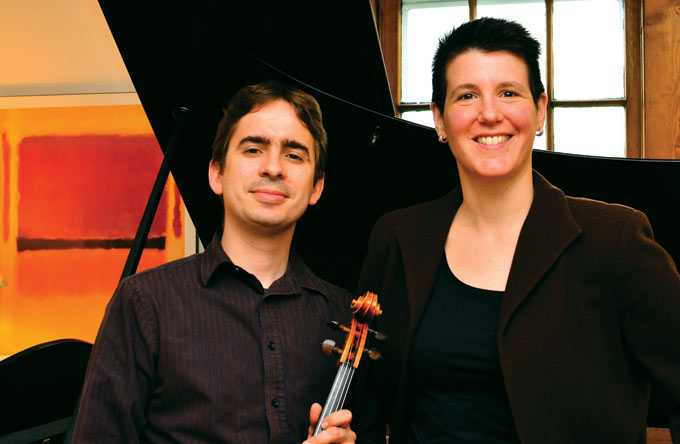Viola Power at the Friends of Vienna
by Jan Jezioro

BPO violist Janz Castelo gives the viola its due
For their final concert of the season on Sunday, April 29 at 3:30pm, in the Unity Church on Delaware Avenue, the Friends of Vienna will feature BPO violist Janz Castelo in a wide-ranging program of music that stretches from the 18th to the 21st century. Joining him will be pianist Alison d’Amato, who has taught at UB and who teaches currently at the Eastman School of Music in Rochester, and local freelance clarinetist Katherine Jarvis, who often performs with the Buffalo Chamber Players. While Castelo has performed often enough locally as a chamber musician, with the Buffalo Chamber Players and otherwise, this will be his first recital as a featured performer since coming to Buffalo.
A graduate of the Peabody Institute of Music in Baltimore, where he was a full scholarship student of Victoria Chiang and Roberto Diaz, Castelo served as associate principal violist of the Portland Symphony Orchestra in Maine before joining the BPO in 2001. Janz and his wife, Ellen Barnum, a bassoonist who is on the faculty of the music department at Buffalo State College, are the parents of two very young sons, and you might think that his family and the hectic BPO schedule would keep him busy enough, but he had other ideas when he founded the Buffalo Chamber Players five years ago.
“Playing as a member of a string section of a symphonic orchestra like the BPO demands that you blend your sound into that of the other players in your section,” Castelo says, “and that’s why I’ve also always enjoyed playing chamber music. If you are playing a piece written for viola and piano, each of you has, say 40 percent input into what decisions to make as to how the score should be interpreted, and you then argue about the remaining 20 percent, and the result is some exciting music-making. Violists like to make their own paths, perhaps due to the relatively late development of the viola as a solo instrument. One of the reasons that I started the Buffalo Chamber Players, many of whose members are also members of the BPO, was not only to give the public the opportunity to hear selections from the huge, underplayed repertoire of chamber pieces that were written for other combinations besides the standard string quartet or piano trio, but to offer orchestral musicians the gratifying opportunity to play as an individual voice.”
The story goes that Mozart composed his popular Trio in E Flat for Clarinet, Viola, and Piano, K. 498 while playing in a game of skittles, hence its nickname, the “Kegelstatt,” which might be translated as “Skittle Alley.” It might seem highly improbable that anyone would be able to compose such a subtly cerebral yet very lyrical work while bowling. However, if we remember that the teenage Mozart heard Allegri’s Miserere—the score of which was closely guarded by the Vatican on pain of excommunication—performed only once in the Sistine Chapel, and was then able to accurately write down the complex music from memory, then the story should not be dismissed out of hand.
Schumann, who suffered from a lifelong mental disorder that first manifested itself in 1833 as a severe melancholic depressive episode, composed his Märchenbilder for Viola and Piano, Op.113 in 1851, towards the end of his life. Castelo says that “the four highly evocative movements may reflect his mental state at the time, as the most blissful mood turns on a dime, musically speaking, to a mood of deep despair—a genuine challenge for the performers.”
German composer Hindemith immigrated to America in 1940, and his first position was at the University of Buffalo, due to the efforts of Cameron Baird, who had studied with Hindemith in Berlin. Hindemith was an accomplished violist, and he composed many chamber works for the instrument, including his 1919 Sonata for Viola and Piano, Op. 11, No.4. Written just after the composer’s active service on the Russian front, the immediately accessible work reflects the post-Romantic sensibilities of the pre-war era. Unlike many of the composer’s later works, Castelo observes, “audience members may go home humming some of its melodies.”
Buffalo-based composer Caroline Mallonée wrote her Lullaby for viola solo in 2008, as part of a collection of pieces called String Tunes. “I’m sure I was thinking of Brahms’s Lullaby when I wrote the opening section,” she says. Since she and her husband, pianist Eric Huebner, who was featured on the last previous Friends of Vienna concert, recently became first-time parents, the inclusion of Lullaby on Sunday’s program seems very appropriate.
For more information, visit www.friendsofvienna.org.
blog comments powered by Disqus|
Issue Navigation> Issue Index > v11n17 (Week of Thursday, April 26) > Viola Power at the Friends of Vienna This Week's Issue • Artvoice Daily • Artvoice TV • Events Calendar • Classifieds |









 Current Issue
Current Issue